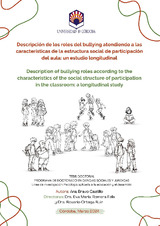Mostrar el registro sencillo del ítem
Descripción de los roles del bullying atendiendo a las características de la estructura social de participación del aula: un estudio longitudinal
| dc.contributor.advisor | Romera Félix, Eva M. | |
| dc.contributor.advisor | Ortega Ruiz, Rosario | |
| dc.contributor.author | Bravo Castillo, Ana | |
| dc.date.accessioned | 2024-03-21T10:59:14Z | |
| dc.date.available | 2024-03-21T10:59:14Z | |
| dc.date.issued | 2024 | |
| dc.identifier.uri | http://hdl.handle.net/10396/27723 | |
| dc.description.abstract | La adolescencia es un período de importantes cambios cognitivos, sociales y físicos, que se desarrollan principalmente en el marco de los iguales y en contextos que mantienen una tenue conexión con la sociedad adulta (Veenstra & Laninga-Wijnen, 2023). En esta etapa evolutiva el grupo de clase se configura como uno de los escenarios sociales de mayor riqueza interactiva con los iguales. La actividad compartida que se genera en las aulas de los centros educativos está en la base de la construcción de complejos sistemas relacionales que les permiten aprender y consolidar sus propios estilos de gestión de la vida social. Las dinámicas de interacción que se generan no ocurren en aislado, sino que suceden dentro de una estructura social compleja basada en patrones de preferencia social y popularidad, en la asunción de diferentes roles sociales que definen sus comportamientos, y en un sistema normativo que sostiene el tipo de interacciones que se desarrollan en el grupo (Benner & Crosnoe, 2023; Ortega-Ruiz, 2020). Toda esta complejidad de elementos sociales, relacionales, normativos y de roles configuran la propia estructura social de participación del aula (Ortega-Ruiz, 2002), llenando de significados y valores compartidos la microcultura de los iguales. El estudio y la descripción de la compleja dinámica social del aula resulta fundamental para poder identificar claves relevantes para promover la convivencia y prevenir la violencia escolar. (...) | es_ES |
| dc.description.abstract | Adolescence is a period of major cognitive, social, and physical changes, which take place mainly among peers and in contexts which are linked tenuously to adult society (Veenstra & Laninga-Wijnen, 2023). At this particular evolutionary stage, the classroom which an adolescent belongs to at school is probably the social setting which generates the greatest profusion of interactions between peers. The activities adolescents take part in together in the classroom at school enable them to start constructing complex relational systems which result in them learning and consolidating their own approaches to managing their social lives. These dynamics of interaction which are generated do not occur in isolation, but rather within a complex social structure based on patterns of social preference and popularity, as they asume the different social roles which define their behavior, and as part of a regulatory system which sustains the type of interactions that occur within the group (Benner & Crosnoe, 2023; Ortega- Ruiz, 2020). All these complex elements of social, relational, normative and role behavior make up the social structure of participation of the classroom (Ortega-Ruiz, 2002), imbuing the microculture of peer-groups with shared meanings and values. It is therefore essential to study and describe the complex social dynamics of the classroom in order to identify key areas which can foster convivencia and prevent school violence. (...) | |
| dc.format.mimetype | application/pdf | es_ES |
| dc.language.iso | spa | es_ES |
| dc.publisher | Universidad de Córdoba, UCOPress | es_ES |
| dc.rights | https://creativecommons.org/licenses/by-nc-nd/4.0/ | es_ES |
| dc.subject | Psicología | es_ES |
| dc.subject | Adolescentes | es_ES |
| dc.subject | Acoso escolar | es_ES |
| dc.subject | Popularidad | es_ES |
| dc.subject | Relaciones sociales | es_ES |
| dc.subject | Psycology | es_ES |
| dc.subject | Adolescents | es_ES |
| dc.subject | Bullying | es_ES |
| dc.subject | Popularity | es_ES |
| dc.subject | Social relationships | es_ES |
| dc.title | Descripción de los roles del bullying atendiendo a las características de la estructura social de participación del aula: un estudio longitudinal | es_ES |
| dc.title.alternative | Description of bullying roles according to the characteristics of the social structure of participation in the classroom: a longitudinal study | es_ES |
| dc.type | info:eu-repo/semantics/doctoralThesis | es_ES |
| dc.relation.projectID | Gobierno de España.AEI/PID2020-113911RB-I00 | |
| dc.relation.projectID | Gobierno de España.MCIN/PSI2016-74871-R | |
| dc.relation.projectID | Gobierno de España.MCIU.FPU 18_01637 | |
| dc.rights.accessRights | info:eu-repo/semantics/openAccess | es_ES |

